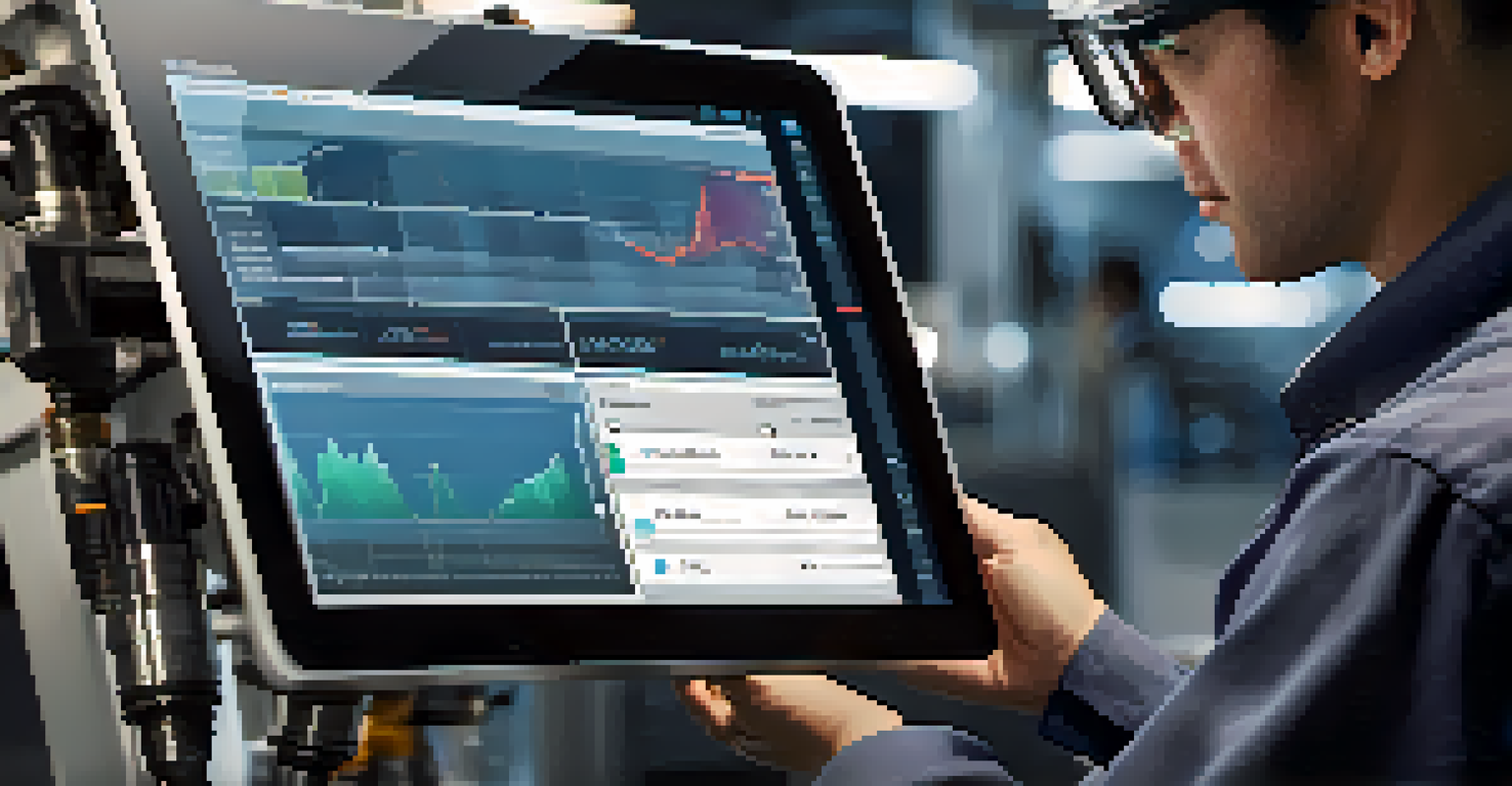Key Metrics for Evaluating AI Predictive Maintenance Success

Understanding Predictive Maintenance and Its Importance
Predictive maintenance refers to the use of AI and data analytics to predict when equipment will fail, allowing for timely interventions. This proactive approach enhances operational efficiency and reduces downtime, which is critical in industries where every minute counts. By leveraging predictive maintenance, organizations can save money and improve service delivery.
An ounce of prevention is worth a pound of cure.
The importance of predictive maintenance lies not just in its ability to prevent breakdowns but also in its capacity to extend the lifespan of equipment. This can translate to significant cost savings over time, as regular maintenance is often cheaper than unexpected repairs. Companies that embrace this strategy can also foster a culture of innovation and efficiency.
In a rapidly evolving technological landscape, understanding how to measure the success of predictive maintenance initiatives is crucial. Key metrics can help organizations assess their effectiveness and guide future investments in AI technologies.
Key Performance Indicators (KPIs) for Predictive Maintenance
When evaluating predictive maintenance success, Key Performance Indicators (KPIs) are essential. These measurable values provide insights into various aspects of the maintenance process, allowing teams to identify areas for improvement. Common KPIs include overall equipment effectiveness (OEE), mean time to repair (MTTR), and mean time between failures (MTBF).

By focusing on OEE, organizations can gauge how efficiently their equipment is functioning in terms of availability, performance, and quality. MTTR helps track the average time taken to repair equipment, which can highlight responsiveness and efficiency in maintenance efforts. Meanwhile, MTBF measures the average time between failures, giving insights into reliability and the effectiveness of maintenance strategies.
Predictive Maintenance Saves Costs
By preventing unexpected equipment failures, predictive maintenance significantly reduces repair costs and lost production time.
Monitoring these KPIs not only helps in evaluating current performance but also aids in forecasting future maintenance needs. As trends emerge, businesses can adjust their strategies accordingly, ensuring they remain competitive and responsive to their operational challenges.
Cost Savings as a Metric of Success
One of the most tangible metrics for evaluating predictive maintenance success is cost savings. By preventing unexpected equipment failures, organizations can significantly reduce repair costs and lost production time. This financial impact is often the first indicator of a successful predictive maintenance program.
What gets measured gets managed.
Additionally, tracking maintenance costs over time can reveal trends and areas where efficiency can be improved. For instance, if predictive maintenance leads to a notable decrease in emergency repairs, it's a clear sign of success. Companies can then reinvest those savings into further improvements or innovations.
Furthermore, understanding the return on investment (ROI) for predictive maintenance initiatives can bolster internal support for these programs. A strong ROI can help justify the upfront costs of implementing AI technologies and motivate stakeholders to commit to ongoing maintenance efforts.
Equipment Reliability and Uptime Metrics
Equipment reliability and uptime are critical metrics for assessing the effectiveness of predictive maintenance. High reliability means that machinery operates as intended with minimal interruptions, while uptime measures the percentage of time equipment is operational. Monitoring these metrics helps organizations ensure they are getting the most out of their investments.
By analyzing reliability data, businesses can identify patterns that may indicate potential failures. This proactive approach allows maintenance teams to intervene before issues escalate, thus safeguarding productivity. In many cases, a successful predictive maintenance strategy results in improved reliability metrics, reflecting a well-maintained operation.
Data Quality Drives Success
The effectiveness of AI-driven predictive maintenance hinges on the quality and accuracy of the data used to make predictions.
Moreover, consistent uptime can enhance customer satisfaction and boost overall business reputation. When customers see that a company is reliable and efficient, they are more likely to continue their relationship, which can lead to long-term success.
Employee Engagement and Training Success Metrics
While often overlooked, employee engagement is a vital metric for evaluating predictive maintenance success. Engaged employees are more likely to adopt new technologies and processes effectively, leading to improved outcomes. Training programs that emphasize predictive maintenance best practices can have a lasting impact on team performance.
Tracking training completion rates and employee feedback can provide valuable insights into the effectiveness of these initiatives. If employees feel well-equipped to utilize predictive maintenance tools, they are more likely to contribute positively to the program's success. Additionally, regular assessments can help identify knowledge gaps and areas for further training.
Ultimately, fostering a culture of continuous learning and improvement can significantly enhance the effectiveness of predictive maintenance efforts. Engaged employees are more likely to embrace change, driving innovation and operational efficiency.
Data Quality and Accuracy as a Measurement Metric
The success of AI-driven predictive maintenance heavily relies on the quality and accuracy of the data being used. If the data is flawed or inconsistent, the predictions made by AI systems will be less reliable, leading to misguided maintenance efforts. Therefore, organizations must prioritize data management as a critical metric.
Regular audits and validation processes can help ensure that the data feeding into predictive maintenance systems is both accurate and relevant. This can involve cleaning the data, removing duplicates, and ensuring that all necessary information is captured. By maintaining high data quality, businesses can trust the insights generated by their AI systems.
Customer Satisfaction Matters
Effective predictive maintenance leads to higher customer satisfaction by ensuring reliable equipment performance and timely service.
In addition, tracking the sources of data and their accuracy can offer insights into potential improvements. Organizations may find that certain sensors or data sources yield more reliable information, allowing them to optimize their predictive maintenance strategies.
Customer Satisfaction Metrics Related to Maintenance
Customer satisfaction is an often overlooked yet crucial metric for evaluating the success of predictive maintenance initiatives. When equipment is maintained properly and operates reliably, customer satisfaction tends to increase. Happy customers are essential for business growth and sustainability, making it vital to connect maintenance efforts with customer perceptions.
Surveys and feedback mechanisms can be implemented to gather insights from customers about their experiences with products and services. If customers report fewer issues or express appreciation for timely service, it's a strong indicator that predictive maintenance is paying off. These insights can guide future maintenance strategies and enhancements.

Moreover, organizations can use customer satisfaction data to benchmark against competitors. Understanding how maintenance efforts impact customer perceptions can help businesses stay ahead in their industries and foster long-term loyalty.
Conclusion: The Holistic View of Predictive Maintenance Metrics
In conclusion, evaluating the success of AI-driven predictive maintenance requires a holistic approach that encompasses various metrics. From cost savings and equipment reliability to employee engagement and customer satisfaction, each metric offers valuable insights into the effectiveness of maintenance strategies. By leveraging these key metrics, businesses can drive continuous improvement and innovation.
It's essential to remember that predictive maintenance is not a one-size-fits-all solution. Organizations should tailor their metrics to align with their specific operational goals and industry demands. This customization can ensure that the metrics are relevant and actionable.
Ultimately, the success of predictive maintenance lies in a commitment to ongoing evaluation and adaptation. By continually assessing and refining their strategies, organizations can harness the full potential of AI technologies and achieve lasting success.